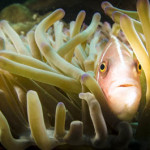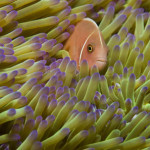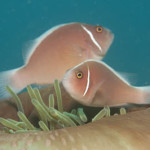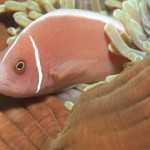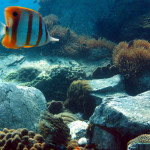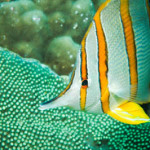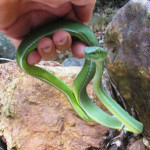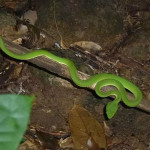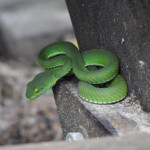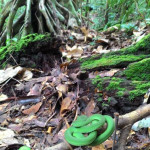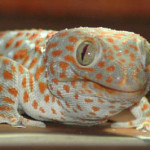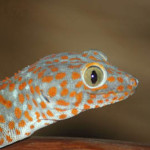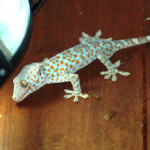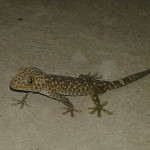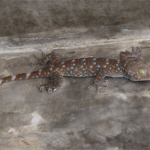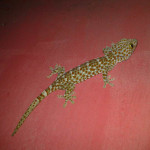Clark’s Anemonefish (Amphiprion clarkii)
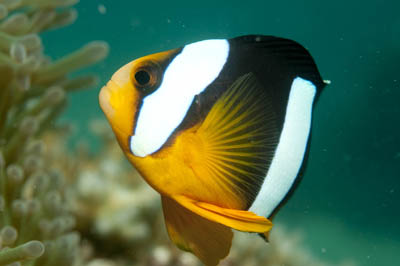
Observed: Koh Chang Reefs,
Observed By: Jonathan Milnes
Like all of the clownfish family Clark’s anemonefish has a symbiotic relationship with the poisonous sea anenomes that provide them shelter. they are impervious to the venom of their host and they protect the anemones from predation by other species and are in turn protected from attack by their host. A pretty fair deal.
Also they are sequential hermaphrodites with strict gender and size based hierarchies. This means that if one of them dies another will change gender and role to fill the gap. This is fascinating, read about it here. Imagine that system applied to humanity.
Clark’s Anemonefish has a bright orange, black and white coloration and is a common resident of the anemones of Koh Chang’s coral reefs.
Clark’s Anemonefish Wikipedia
Pink Skunk Clownfish (Amphiprion perideraion)
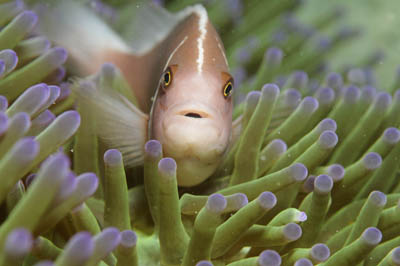
Image Copyright Jonathan Milnes
Observed: Koh Chang Reefs,
Observed By: Jonathan Milnes
Don’t think Nemo! Clownfishes are amazing beasts in all kinds of ways. First up is their symbiotic relationship with the poisonous sea anenomes that provide them shelter. they are impervious to the venom of their host and they protect the anemones from predation by other species and are in turn protected from attack by their host. A pretty fair deal.
Also they are sequential hermaphrodites with strict gender and size based hierarchies. This means that if one of them dies another will change gender and role to fill the gap. This is fascinating, read about it here. Imagine that system applied to humanity.
They are feisty little things, as divers will tell you, and not at all intimidated by size, but stay out of their territory and you’ll be left alone.
Pink Skunk Clownfish Wikipedia
Image Copyright Jonathan Milnes
Image Copyright Jonathan Milnes
Image Copyright Jonathan Milnes
Image Copyright Jonathan Milnes
Copperband Butterflyfish (Chelmon rostratus)
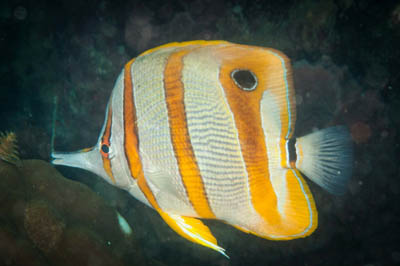
Image Copyright Jonathan Milnes
Observed: Koh Chang Reefs
Observed by: Jonathan Milnes
The Copperband butterflyfish is also known as the Beaked coral fish. It lives around coral and has quite a pronounced beak so that kind of makes sense. It also has one of those false eye patterns, common in nature, that protect the actual eye of the wearer by having a much larger fake eye effect in a less vulnerable part of the body. Evolution is a wonderful thing and this cunning trick has clearly helped the Copperband to survive.
Copperband Butterflyfish Wikipedia
Image Copyright Ian Gostelow
Image Copyright Jonathan Milnes
Blue Ring Angelfish (Pomacanthus annularis)
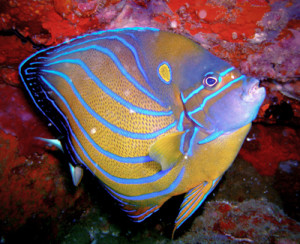
Image Copyright Jonathan Milnes
Observed: Koh Chang Reefs
Observed by: Jonathan Milnes
The beautiful blue ring angelfish is thankfully a fairly common sight on Koh Chang’s reefs. It is a voracious feeder eating algae, coral, other fish, shrimps and pretty much anything it can sink its teeth into.
Blue ring angelfish Wikipedia
Oriental Magpie-Robin (Copsychus saularis)
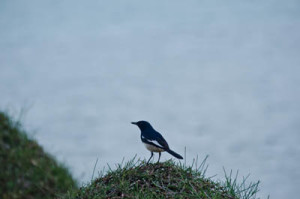
Observed: Koh Chang, February 2015
Observed By: David Vinot
The poor old Oriental magpie-Robin has been the victim of confusion. At first it was thought to be a member of the thrush family but these days it has been classified as an old-world flycatcher, whatever that is. Add to that the fact that it’s called a magpie -Robin because it looks like a robin sized magpie and it’s a grand recipe for confusion.
What we do know, however, is that it is a pretty little black and white bird that lives on Koh Chang.
Oriental Magpie-Robin Wikipedia
Black-Naped Monarch (Hypothymis azurea)
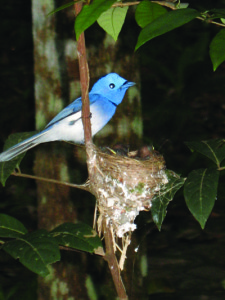 Observed: Koh Chang
Observed: Koh Chang
Observed By: Dave Hinchliffe
The Black-Naped Monarch, aka the Black-Naped Blue flycatcher is a small Koh Chang native bird with a beautiful, almost iridescent, blue plumage. they are tropical forest dwellers and the male of the species has the brighter plumage and the distinctive black nape stripe.
Black-Naped Monarch Wikipedia
Red Junglefowl (Gallus gallus)
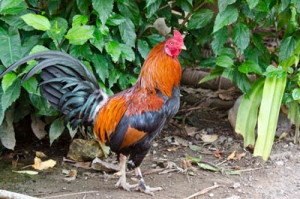 Observed: Koh Chang, February 2015
Observed: Koh Chang, February 2015
Observed By: David Vinot
The Red Junglefowl is the bird that was domesticated as the chicken. Koh Chang has more than its fair share of domestic chickens, as you will be reminded ad nauseum by their fiercely annoying cries at dawn and often before. Some of them are wild or only in semi-captivity, roaming all over the place staring at you with their funny eyes protruding from their horrid novelty condom heads. So whether this counts as a native species or not there are certainly an awful lot of them on Koh Chang.
Eggs are useful though and chicken tastes good.
Red Junglefowl Wikipedia
Red Collared Dove (Streptopelia tranquebarica)
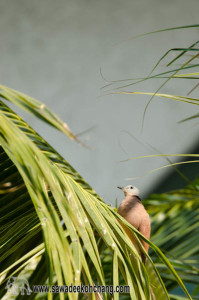
Observed: Koh Chang, February 2015
Observed By: David Vinot
The Red Collared Dove, aqlso known as the Red Turtle Dove, is a member of the pigeon family but with it’s elegant pinkish feathers it seems a very long way from the thuggish, scruffy, streetwise pigeons that blight many towns and cities.
Red Collared Dove Wikipedia
White-Lipped Pit Viper (Trimeresurus albolabris)
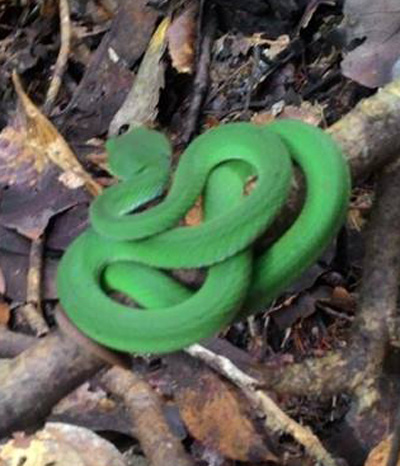
Image Copyright 2015 Teerasak Thomas Suamcheepmasau
Last Observed: November 2015, Koh Chang
Observed By: Teerasak Thomas Suamcheepmasau, Paul Mann, Jean-Pierre Odet
The White-Lipped Pit Viper is a brilliant emerald green species of poisonous snake that is native to Southeast Asia. The aren’t too big, growing to a maximum length of 81cm, but that’s big enough when you’ve got poison. They aren’t a threatened species nor are they a particularly threatening one and they’ll be happy to leave you alone if you return the favour.
White-Lipped Pit Viper Wikipedia
Image Copyright Paul Mann
Image Copyright Jean-Pierre Odet
Image Copyright Jean-Pierre Odet
Image Copyright Teerasak Thomas Suamcheepmasau
Tokay Gecko (Gekko Gekko)
Last Observed: October 2015, Lonely Beach, Koh Chang
Observed By: David Newman
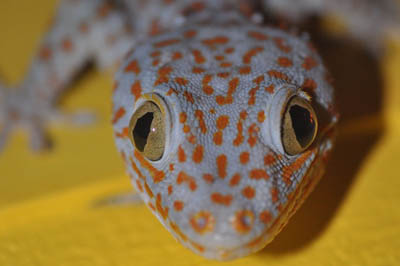
Image Copyright 2015 David Newman
The Tokay Gecko is a large and aggresive lizard common across Southern and Southeast Asia. It is an fierce predator and noted for it’s loud and repetitive cries which, whilst in English are recorded Ge-Ko Ge-Ko, also are the root of the Thai name Too-Kare Too-Kare (both are onomatopoeic names – named after the sound they make).
They are very attractive creatures with their characteristic orange spotted skin. But they are almost universally reviled and demonized by the Thais, many of whom have an almost phobic reaction to them. This seems strange to non-Thais, especially in a country with no shortage of poisonous and dangerous snakes, spiders, insects, scorpions, centipedes and marine animals. Not to mention tigers. But it seems to be the Gecko that is the Thai’s most feared beast. They certainly aren’t afraid of people and I guess they would give you a bit of a bite if you really went looking for it but they have all kinds of good qualities as well. For a start they eat cockroaches, mosquitoes and all kinds of other insects, protecting people from bites, stings and disease. And they sound, and look, pretty cool.
They are the second largest species of Gecko and males can reach 51cm, that’s a pretty big lizard. The males are very territorial and a fight between two of them is a thing to see.
Tokay Lizard Wikipedia
Image Copyright 2015 David Newman
Image Copyright 2015 David Newman
Image Copyright 2015 David Newman



